![]()
![]()
![]()
Use LEFT and RIGHT arrow keys to navigate between flashcards;
Use UP and DOWN arrow keys to flip the card;
H to show hint;
A reads text to speech;
408 Cards in this Set
- Front
- Back
- 3rd side (hint)
|
Bennett |
Fracture at base of first metacarpal |
|
|
|
Boxer |
Fracture of metacarpal neck |
|
|
|
Colles |
Fracture of distal radius with posterior displacement |
|
|
|
Smith |
Fracture of distal radius with anterior displacement |
|
|
|
Buckle |
Impacted fracture with bulging of periosteum |
|
|
|
Gout |
Hereditary form of arthritis in which uric acid is deposited in joints |
|
|
|
Osteomyelitis |
Inflammation of bone owing to pyogenic infection |
|
|
|
Osteopetrosis |
Increased density of atypically soft bone |
|
|
|
Osteoporosis |
Loss of bone density |
|
|
|
Rheumatoid Arthritis |
Inflammatory collagen disease |
|
|
|
Hand |
Consists of 27 bones |
|
|
|
Phalanges |
Bones of the digits |
|
|
|
Metacarpals |
Bones of the palm |
|
|
|
Carpals |
Bones of the wrist |
|
|
|
First digit |
Thumb |
|
|
|
Digits |
14 phalanges Long bones |
|
|
|
1st digit |
2 phalanges (proximal & distal) |
|
|
|
Distal phalanges PHALANGEAL TUFT |
Spatula like rum around distal anterior end |
|
|
|
Metacarpals |
5 metacarpals form the palm Long bones Head- (knuckles)-distally Base-proximally |
|
|
|
Wrist |
8 carpal bones Short bones |
|
|
|
Proximal row of wrist |
Scaphoid-navicular Lunate-semilunar Triquetrum-Triquetral,cuneiform, or triangular Pisiform |
|
|
|
Distal row of wrist |
Trapezium- Greater multangular Trapezoid- Lesser multangular Capitate- Os magnum Hamate- Unciform |
|
|
|
Metacarpophalangeal Joint |
Synovial diarthrodial ellipsoidal joints |
|
|
|
Diarthrodial freely moveable |
All joints of the hand are__ |
|
|
|
1st carpometacarpal joint |
Synovial saddle |
|
|
|
Proximal carpals |
Articulate with RADIUS |
|
|
|
1st metacarpal and trapezium |
Synovial SADDLE joint |
|
|
|
ANATOMIC SNUFFBOX |
Located on posterior surface of wrist- formed by tendons of the two major muscles of thumb Fracture of scaphoid-most commonly fractured carpal bone |
|
|
|
CARPAL SULCUS |
Anterior or palmar surface of wrist is concave from side to side and forms the carpal sulcus |
|
|
|
FLEXOR RETINACULUM |
Strong fibrous band which attaches medically to pisiform |
|
|
|
Carpal tunnel |
MEDIAN NERVE and flexor tendons pass through carpal canal |
|
|
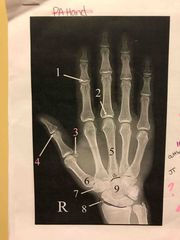
Front (Term) |

Back (Definition) |
|
|
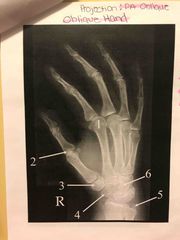
Front (Term) |

Back (Definition) |
|
|
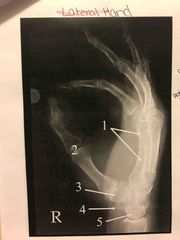
Front (Term) |
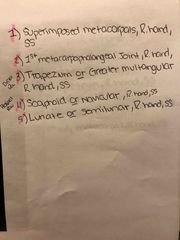
Back (Definition) |
|
|
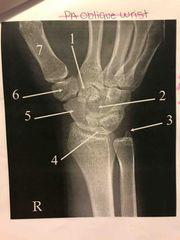
Front (Term) |
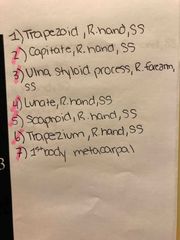
Back (Definition) |
|
|
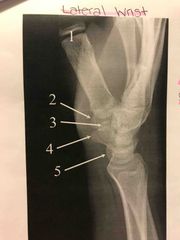
Front (Term) |
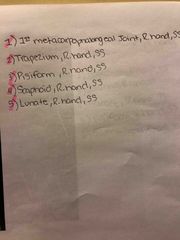
Back (Definition) |
|
|
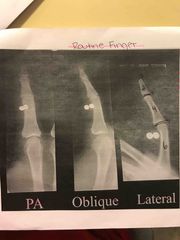
Front (Term) |
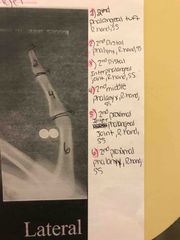
Back (Definition) |
|
|
|
Forearm consists of ______ |
2 bones - radius & ulna |
|
|
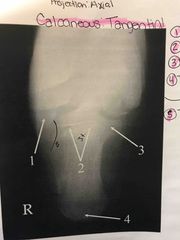
CALCANEOUS: TANGENTIAL |
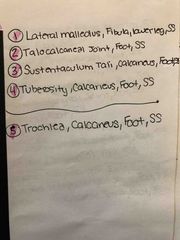
|
|
|
|
Trochlea on ______ side Capitulum on ______ side |
Medial Lateral |
|
|
|
Olecranon fossa ____ |
Deep depression found behind coronoid fossa on posterior surface |
|
|
|
Proximal end of humerus contains the |
Head |
|
|
|
Below the head of humerus is the |
Anatomic neck |
|
|
|
Below the tubercles of the humerus is the |
Surgical neck SITE OF MANY FRACTURES |
|
|
|
Lesser tubercle on the |
Anterior side |
|
|
|
Greater tubercle in profile |
AP |
|
|
|
Greater tubercle on the |
Lateral side |
|
|
|
On the humerus what separates the tubercles |
Deep depression called the Intertubercular groove |
|
|
|
Intertubercular groove is also called |
Bicipital |
|
|
|
Olecranon process or Proximal process |
Forms proximal portion of the trochlear notch |
|
|
|
Humeral and ulnar or radial articulations is |
Synovial |
|
|
|
In a lateral projection the lesser tubercle is |
Facing medially |
|
|
|
Posterior fat pad |
Lies within the OLECRANON FOSSA of posterior humerus |
|
|
|
Supinator fat pad |
Anterior to and parallel with anterior aspect of proximal radius |
|
|
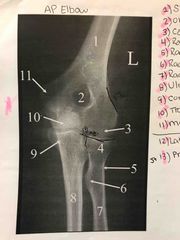
AP Elbow |
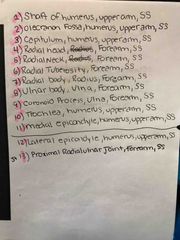
|
|
|
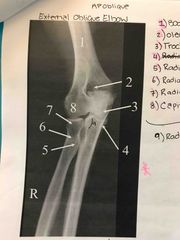
AP Oblique EXTERNAL rotation |
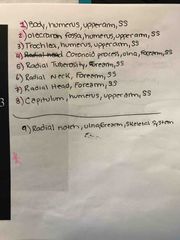
Back (Definition)
G |
|
|

Lateral elbow |
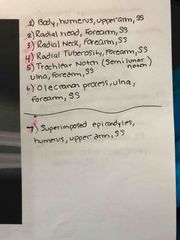
Back (Definition)
H |
|
|
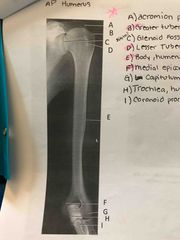
AP humerus |
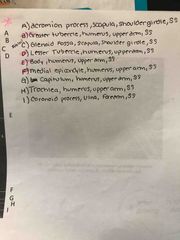
Back (Definition)
H |
|
|
|
Shoulder girdle formed by two bones |
Clavicle and scapula |
|
|
|
Clavicle |
LONG BONE |
|
|
|
Distal process or Coronoid process |
Projects anteriorly and curves slightly superior - forms lower portion of trochlear notch |
|
|
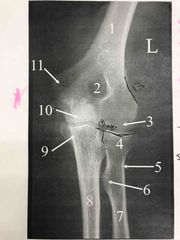
AP Elbow |
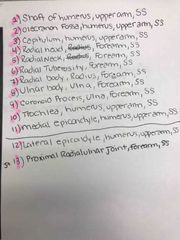
Back (Definition) |
|
|
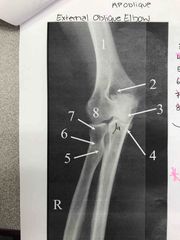
AP Oblique EXTERNAL rotation |

Back (Definition) |
|
|
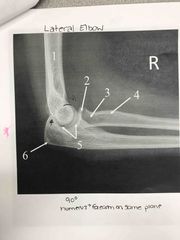
Lateral elbow |

Back (Definition) |
|
|
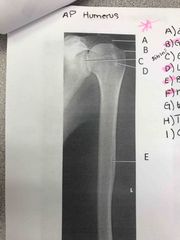
AP humerus |
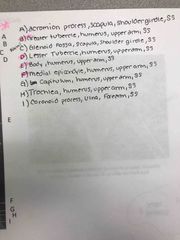
Back (Definition) |
|
|
|
What fossa is on anterior side of scapula? |
SUBSCAPULAR FOSSA |
|
|
|
SUPRASPINOUS fossa |
Depression above scapular spine for muscle attachment |
|
|
|
INFRASPINOUS FOSSA |
Depression below scapular spine for muscle attachment |
|
|
|
ACROMION PROCESS |
Flattened ovoid projection on lateral end of crest of spine |
|
|
|
CORACOID PROCESS |
Beak like process arises from thick base anteriorly |
|
|
|
Superior border |
Extends from superior angle to coracoid process |
|
|
|
Trochlear notch is also called _____ |
Semilunar notch |
|
|
|
Medial border (VERTEBRAL BORDER) |
Extends from superior to inferior angles |
|
|
|
Lateral border |
Extends from glenoid cavity to inferior angle |
|
|
|
Glenoid cavity |
Lateral shallow oval depression |
|
|
|
Superior angle |
Junction of superior and medial borders |
|
|
|
Inferior angle |
Junction of medial and lateral borders |
|
|
|
SCAPULAR NECK |
constructed region around glenoid cavity Site of many scapular fractures |
|
|
|
Small synovial fluid filled sacs is called |
BURSAE |
|
|
|
Scapulohumeral Joint |
BALL AND SOCKET |
|
|
|
Acromioclavicular joint |
GLIDING |
|
|
|
Shoulder girdle and scapula is |
Diarthoses |
|
|
|
Distal end of the ulna with a rounded process on lateral side is called ______ |
Head |
|
|
|
Hill Sachs defect |
Impacted fracture on posterolateral aspect of humeral head with dislocation |
|
|
|
Metastasis |
Transfer of cancerous lesion from one area to another |
|
|
|
Osteopetrosis |
Increased density |
|
|
|
Osteoporosis |
Loss of bone density |
|
|
|
Rheumatoid Arthritis |
Inflammatory collagen disease |
|
|
|
Chondrosarcoma |
Malignant tumor arising from cartilage cells |
|
|
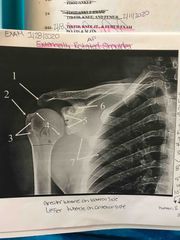
AP externally rotated shoulder |
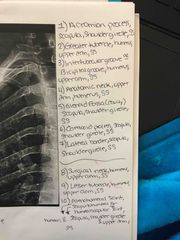
|
|
|
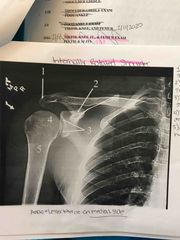
AP internally rotated shoulder |
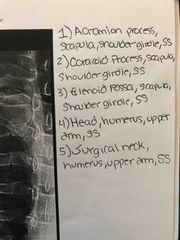
|
|
|
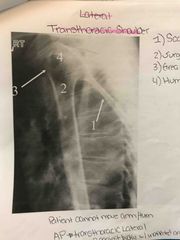
Lateral Transthoracic shoulder |

|
|
|
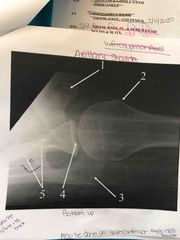
Axilliary shoulder Inferosuperior axial |
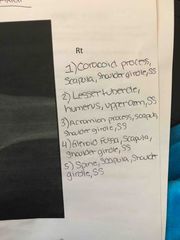
|
|
|
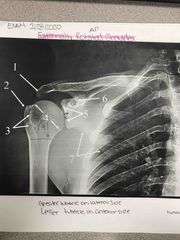
AP externally rotated shoulder |
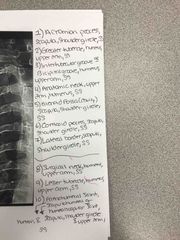
Back (Definition) |
|
|
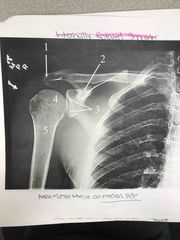
AP internally rotated shoulder |

Back (Definition) |
|
|
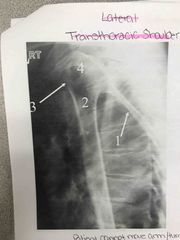
Lateral Transthoracic shoulder |
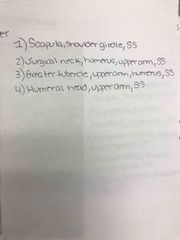
Back (Definition) |
|
|
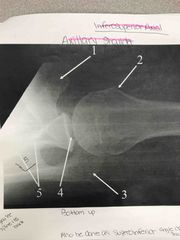
Axilliary shoulder Inferosuperior axial |
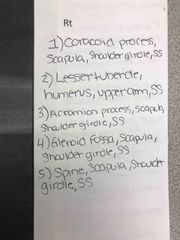
Back (Definition) |
|
|

PA oblique shoulder Lateral view of scapula |
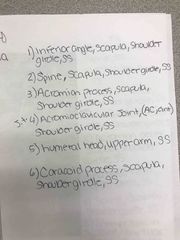
Back (Definition) |
|
|

AP Clavicle |
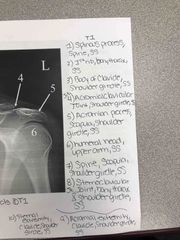
Back (Definition) |
|
|
|
Pott |
Avulsion fracture of medial malleolus with loss of the ankle mortise |
|
|
|
Jones |
Avulsion fracture of base of the fifth metatarsal |
|
|
|
Gout |
Hereditary form of arthritis in which uric acid is deposited into joints |
|
|
|
Osgood-Schlatter disease |
Incomplete separation or avulsion of Tibial tuberosity |
|
|
|
Osteomalacia or Rickets |
Softening of the bones due to vitamin D deficiency |
|
|
|
Proximal end of the radius is small and has a flat disk like ____ |
Head |
|
|
|
Osteopetrosis |
Increased density of atypically soft bone |
|
|
|
Osteoporosis |
Loss of bone density |
|
|
|
Foot contains ___ |
26 bones |
|
|
|
Foot has |
14 phalanges (bones of the toes) |
|
|
|
The 7 tarsals are the ___ |
Bones of the ankle |
|
|
|
The hind foot includes |
Talus & calcaneus |
|
|
|
The forefoot includes |
Metatarsals and toes |
|
|
|
Superior surface of the foot is called |
Dorsal surface or dorsum |
|
|
|
Inferior aspect of the foot |
Plantar surface |
|
|
|
There are how many phalanges of the foot |
14 |
|
|
|
Radial tuberosity ____ |
Roughened process inferior to neck on medial side |
|
|
|
Base of the metatarsals is the |
Expanded PROXIMAL end |
|
|
|
Head of the metatarsals is the |
Small rounded DISTAL end |
|
|
|
The shortest and thickest metatarsal |
1st |
|
|
|
Longest metatarsal |
2nd |
|
|
|
Has a prominent tuberosity on the lateral side of foot |
5th metatarsal |
|
|
|
Calcaneus |
LARGEST AND STRONGEST tarsal bone |
|
|
|
Calcaneal sulcus |
Groove between middle and posterior articulate facets Calcaneal sulcus+ sulcus tali= SINUS TARSI |
|
|
|
_______ Articulates with the tibia |
Trochlear or superior surface |
|
|
|
Sulcus tali |
Groove on inferior surface that forms the roof of the sinus tarsi |
|
|
|
Cuboid |
Lies on the LATERAL side of foot between calcaneus and the 4TH & 5TH METATARSALS |
|
|
|
Distal end of radius has a conic projection on lateral surface called ____ |
Radial styloid process |
|
|
|
Which cuneiform is the largest? |
MEDIAL or 1st cuneiform |
|
|
|
What cuneiform is the smallest? |
Intermediate cuneiform or the 2nd cuneiform |
|
|
|
List names for ALL tarsal bones |
Calcaneus - OS CALCIS Talus- ASTRAGALUS Navicular- SCAPHOID cuboid Cuneiform- Medial OR 1st OR internal Cuneiform- intermediate OR 2nd OR middle Cuneiform- lateral OR 3rd OR external |
|
|
|
Sesamoid bones |
2 sesamoid bones beneath head of 1st metatarsal |
|
|
|
Ankle mortise joint |
Formed by articulations between LATERAL MALLEOLUS of fibula, INFERIOR SURFACE OF TIBIA, and MEDIAL MALLEOLUS of tibia |
|
|
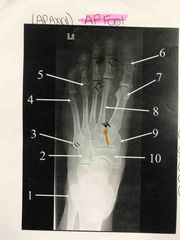
AP FOOT |
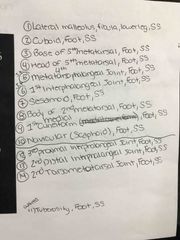
Back (Definition) |
|
|
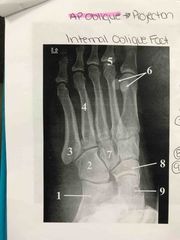
AP OBLIQUE |
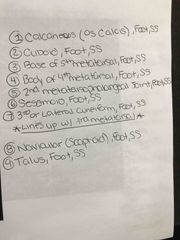
Back (Definition) |
|
|
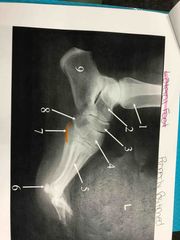
LATERAL FOOT |

Back (Definition) |
|
|
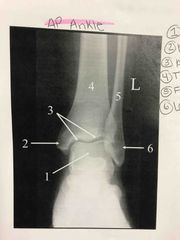
AP ANKLE |
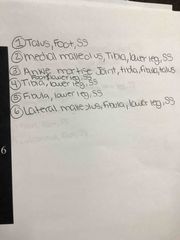
Back (Definition) |
|
|
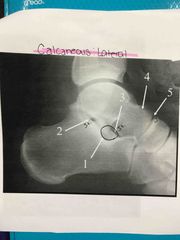
CALCANEOUS :LATERAL |
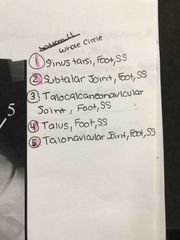
Back (Definition) |
|
|
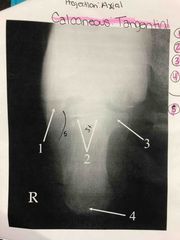
CALCANEOUS: TANGENTIAL |
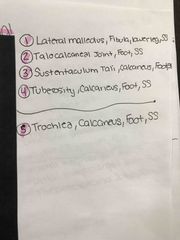
Back (Definition) |
|
|
|
The _____ is the longest, strongest & heaviest bone in the body |
FEMUR |
|
|
|
Distal lateral end of fibula is called ___ |
Lateral malleolus |
|
|
|
The femurs body is convex anteriorly and slants medially ____ |
5-15 DEGREES |
|
|
|
Distal femur has 2 large eminences called |
MEDIAL AND LATERAL CONDYLES |
|
|
|
Femoral condyles separated ANTERIORLY by ___ |
PATELLAR SURFACE |
|
|
|
Posteriorly femoral condyles separated by a deep depression called ___ |
Intercondylar fossa |
|
|
|
Medial femoral condyle contains |
ADDUCTOR TUBERCLE |
|
|
|
Small depression at center of femoral head called ___ |
FOVEA CAPITIS |
|
|
|
Greater trochanter = Lesser trochanter = |
Superolateral Posteromedial |
|
|
|
Femoral neck constricted bear the head and joins body at an angle of ___ |
15-20 DEGREES |
|
|
|
Prominent ridge connecting trochanters POSTERIORLY is |
Intertrochanteric crest |
|
|
|
Proximal end of tibia has 2 prominent processes called _____ |
Medial & lateral condyles |
|
|
|
Ligaments of knee |
Posterior cruciate ligament Anterior cruciate ligament Tibial (medial) collateral ligament Fibular (lateral) collateral ligament |
|
|
|
Patellar is the largest ___ |
Sesamoid bone |
|
|
|
Apex of patella = Base of patella= |
Inferiorly Superiorly Apex lies 1/2” ABOVE knee joint |
|
|
|
Menisci act as a |
SHOCK ABSORBER |
|
|
|
Proximal tibiofibular jt Distal tibiofibular jt |
Diarthoses Amphiarthroses |
|
|
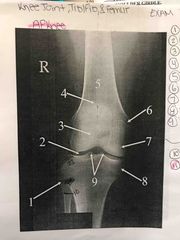
AP knee |
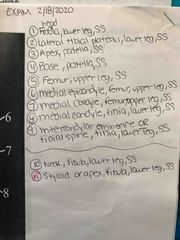
|
|
|
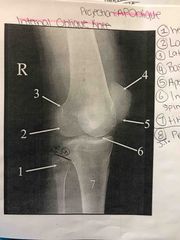
AP oblique knee: INTERNAL ROTATION |
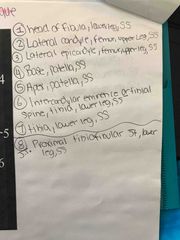
Back (Definition)
H |
|
|
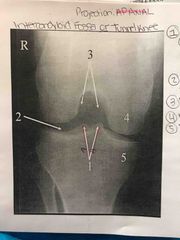
AP AXIAL Tunnel knee |
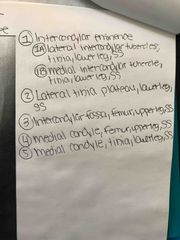
|
|
|
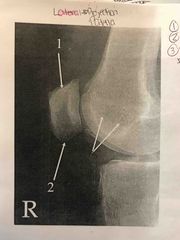
Lateral patella |
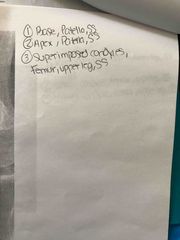
Back (Definition)
G |
|
|
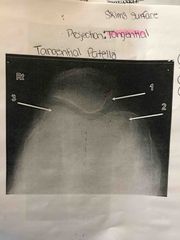
Tangential |
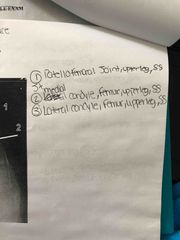
Back (Definition)
G |
|
|
|
Superior surface of condyles are smooth, flat facets for articulation with the femur called ____ |
Tibial plateaus |
|
|

AP Hip |

|
|
|
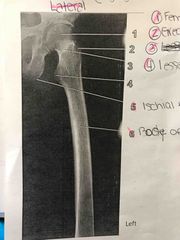
Lateral Hip “Frog leg” position |
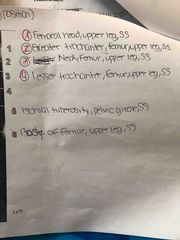
|
|
|
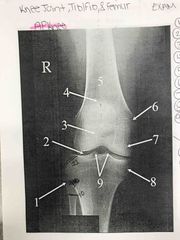
AP knee |
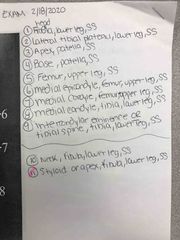
Back (Definition) |
|
|
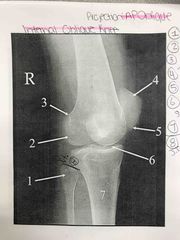
AP oblique knee: INTERNAL ROTATION |
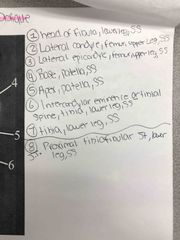
Back (Definition) |
|
|
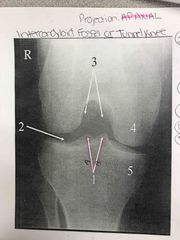
AP AXIAL Tunnel knee |

Back (Definition) |
|
|
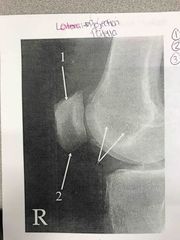
Lateral patella |
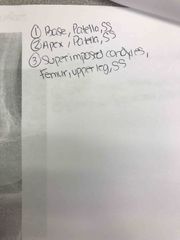
Back (Definition) |
|
|
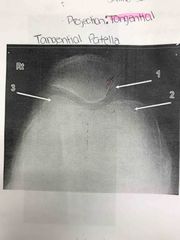
Tangential |
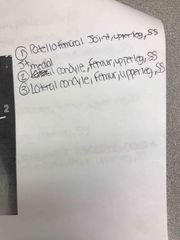
Back (Definition) |
|
|
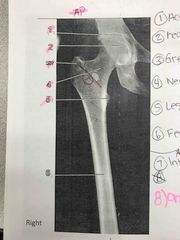
AP |
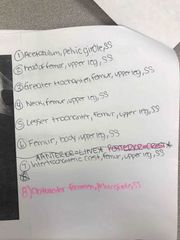
Back (Definition) |
|
|
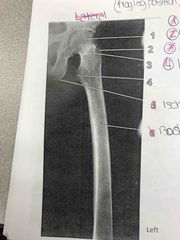
Lateral |
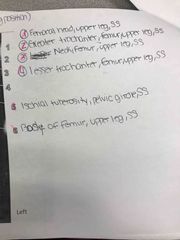
Back (Definition) |
|
|
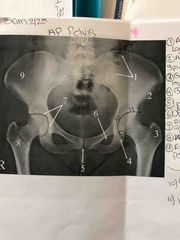
AP Pelvis |
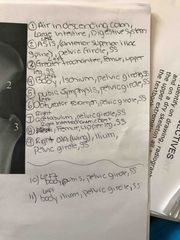
|
|
|
|
Tibial plateaus slope posteriorly ____ |
10-20 DEGREES |
|
|
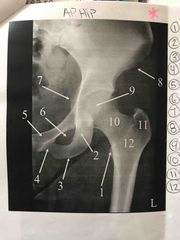
AP Hip |
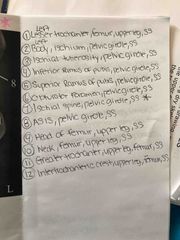
Back (Definition)
T |
|
|

Lateral Hip |

Back (Definition)
T |
|
|
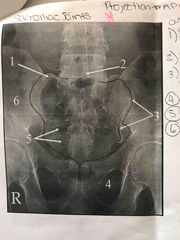
AP Axial Pelvis -SI joints |
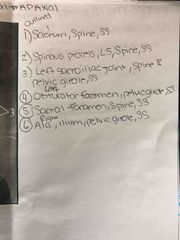
Back (Definition)
T |
|
|
|
What projection? What position? |
AP Oblique RPO |
|
|
|
Hip bone can be referred to as |
Os coxae OR innominate bone |
|
|
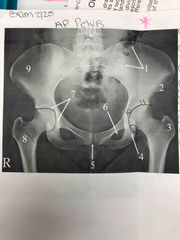
AP Pelvis |
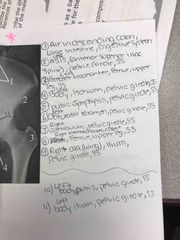
Back (Definition) |
|
|
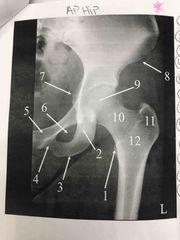
AP Hip |
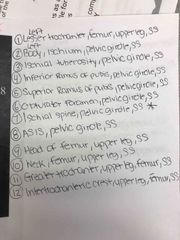
Back (Definition) |
|
|

Lateral Hip |
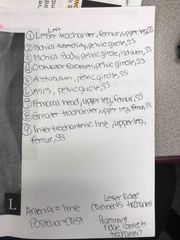
Back (Definition) |
|
|
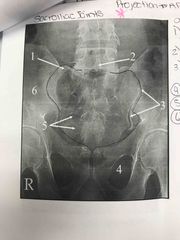
AP Axial |
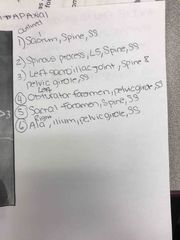
Back (Definition) |
|
|
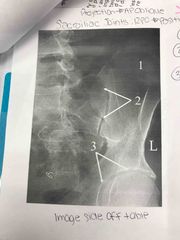
What projection? What position? |
AP Oblique RPO |
|
|
|
Between tibial plateaus is a sharp projection called ___ |
Intercondylar eminence or tibial spines |
|
|
|
Inferior and posterior portions of wing present a large rough surface called _____ for articulation with sacrum |
Auricular surface |
|
|
|
Pubis consists of a body, superior RAMUS and inferior RAMUS |
Body forms 1/5 of acetabulum ANTERIORLY |
|
|
|
The ischium |
-body forms 2/5 of acetabulum POSTERIORLY -when body is in seated or upright position weight rests on 2 ISCHIAL TUBEROSITIES |
|
|
|
Below ischial spine is an indentation called ___ |
Lesser sciatic notch |
|
|
|
Hip Joint |
Ball & socket, diarthrodial |
|
|
|
Pubic symphysis |
Cartilaginous, amphiarthrodial |
|
|
|
Sacroiliac joint |
Irregular gliding, amphiarthrodial |
|
|
|
Female pelvis |
-lighter -wider & shallower -inlet is larger & more oval shaped
|
|
|
|
Pelvis divided into 2 portions by a line that extends from upper margin of _____ to upper margin of _____ |
Sacrum Pubic symphysis |
|
|
|
Region ABOVE brim |
False or greater pelvis |
|
|
|
Intercondylar eminence terminate into 2 peak like processes called ____ |
MEDIAL AND LATERAL INTERCONDYLAR TUBERCLE |
|
|
|
Region below brim |
True or lesser pelvis |
|
|
|
Bony landmarks of Pelvis |
Iliac crest ASIS Pubic symphysis Greater trochanter Ischial tuberosity Tip of coccyx |
|
|
|
Hip joint can be located by palpating the ____ and the ___ |
ASIS and superior margin of the pubis symphysis |
|
|
|
How can you find the femoral neck? |
1)draw a line from ASIS to the top of the pubis symphysis 2) draw a second line perpendicular to that -femoral neck 2 1/2” distal -femoral head 1 1/2” distal |
|
|
|
_____ is in profile when lower leg is medially rotated (internal rotation). |
Greater trochanter |
|
|
|
Anterior proximal surface of tibia has prominent process called ___ |
TIBIAL TUBEROSITY |
|
|
|
Anterior surface of tibial body has a sharp ridge called ___ |
Anterior crest (shin) |
|
|
|
Distal end of tibia has large club shaped process called |
Medial malleolus |
|
|
|
On the fibula the lateroposterior aspect of head is known as ___ |
Apex OR styloid process |
|
|
|
List 2 functions of the spine |
-encloses and protects the spinal cord -acts as support for the trunk -supports skull superiorly -provides attachment for the deep muscles of the back and ribs |
|
|
|
The lumbar curves develop between ___ |
1 to 1 1/2 years of age |
|
|
|
Kyphosis |
Abnormal increase in the anterior concavity of thoracic curve |
|
|
|
Lordosis |
Abnormal increase in the anterior convexity of the lumbar or cervical curve |
|
|
|
Scoliosis |
Abnormal lateral curvature of the spine |
|
|
|
Anterior mass of bone is the ___ |
Body of the vertebra |
|
|
|
Posterior ring like portion called the |
Vertebral arch |
|
|
|
Superior and inferior surfaces of the bodies are flattened and covered by a thin plate of __ |
Articular cartilage |
|
|
|
Each disk has a central mass of soft pulpy semigelatinous material called ______ Surrounded by an outer layer called____ |
Nucleus Pulposus, Annulus Fibrosus |
|
|
|
Common for pulpy nucleus to rupture or protrude into vertebral canal impinging on a spinal nerve is called ____ |
Herniated nucleus pulposus (HNP) |
|
|
|
Vertebral arch formed by |
-2 Pedicles -2 laminae -4 articular processes -2 transverse processes -1 spinous processes |
|
|
|
In early life the vertebral column has ___ small irregular shaped bones |
33!!! |
|
|
|
Superior and inferior surfaces of the pedicles are concave these concavities are called |
Vertebral notches |
|
|
|
The broad flat laminae _____ |
Directed POSTERIORLY and medially from the PEDICLES |
|
|
|
Articulations between articular processes of the vertebral arches are called |
Zygapophyseal joints |
|
|
|
Parts of the lamina between superior and inferior articular processes called ____ |
Pars interarticularis |
|
|
|
Zygopophyseal joints form an angle of _____ |
30-60 degrees to midsagittal plane |
|
|
|
Intervertebral foramina situated at |
Right angles (90 degrees) |
|
|
|
Scotty Dog |
Ear- superior articular process nose- transverse process Eye-Pedicle Neck-pars interarticularis Body-lamina Front leg-inferior articular process |
|
|
|
The ____ composed of 3 to 5 vertebrae to fuse into one bone in the adult |
Coccyx |
|
|
|
The vertebral column is divided into 5 groups T/F |
True |
|
|
|
24 vertebral segments in the upper three regions remain distinct throughout life and are called true or movable vertebrae name the 3 |
Cervical,Thoracic,& lumbar vertebrae |
|
|
|
Viewed from the side the vertebral column has 4 curves that arch anteriorly and posteriorly from the midcoronal plane |
TRUE not 3 |
|
|
|
Cervical and lumbar curves are CONVEX ANTERIORLY called ____ |
Lordotic curves |
|
|
|
Thoracic and pelvic curves are CONCAVE ANTERIORLY called____ |
Kyphotic curves |
|
|
|
The thoracic and pelvic curves are also called PRIMARY curves bc they are ____ |
Present at birth |
|
|
|
Cervical and lumbar curves are called secondary or compensatory curves bc ____ |
They develop after birth |
|
|
|
The cervical curve develops between ____ |
3-9 months of age |
|
|
|
List 2 functions of the spine |
-encloses and protects the spinal cord -acts as support for the trunk -supports skull superiorly -provides attachment for the deep muscles of the back and ribs |
|
|
|
The lumbar curves develop between ___ |
1 to 1 1/2 years of age |
|
|
|
Kyphosis |
Abnormal increase in the anterior concavity of thoracic curve |
|
|
|
Lordosis |
Abnormal increase in the anterior convexity of the lumbar or cervical curve |
|
|
|
Scoliosis |
Abnormal lateral curvature of the spine |
|
|
|
Anterior mass of bone is the ___ |
Body of the vertebra |
|
|
|
Posterior ring like portion called the |
Vertebral arch |
|
|
|
Superior and inferior surfaces of the bodies are flattened and covered by a thin plate of __ |
Articular cartilage |
|
|
|
Each disk has a central mass of soft pulpy semigelatinous material called ______ Surrounded by an outer layer called____ |
Nucleus Pulposus, Annulus Fibrosus |
|
|
|
Common for pulpy nucleus to rupture or protrude into vertebral canal impinging on a spinal nerve is called ____ |
Herniated nucleus pulposus (HNP) |
|
|
|
Vertebral arch formed by |
-2 Pedicles -2 laminae -4 articular processes -2 transverse processes -1 spinous processes |
|
|
|
In early life the vertebral column has ___ small irregular shaped bones |
33!!! |
|
|
|
Superior and inferior surfaces of the pedicles are concave these concavities are called |
Vertebral notches |
|
|
|
The broad flat laminae _____ |
Directed POSTERIORLY and medially from the PEDICLES |
|
|
|
Articulations between articular processes of the vertebral arches are called |
Zygapophyseal joints |
|
|
|
Parts of the lamina between superior and inferior articular processes called ____ |
Pars interarticularis |
|
|
|
Zygopophyseal joints form an angle of _____ |
30-60 degrees to midsagittal plane |
|
|
|
Intervertebral foramina situated at |
Right angles (90 degrees) |
|
|
|
Scotty Dog |
Ear- superior articular process nose- transverse process Eye-Pedicle Neck-pars interarticularis Body-lamina Front leg-inferior articular process |
|
|
|
The ____ composed of 3 to 5 vertebrae to fuse into one bone in the adult |
Coccyx |
|
|
|
AP lumbar spine |
Back (Definition)t |
|
|
|
The vertebral column is divided into 5 groups T/F |
True |
|
|
|
24 vertebral segments in the upper three regions remain distinct throughout life and are called true or movable vertebrae name the 3 |
Cervical,Thoracic,& lumbar vertebrae |
|
|
|
Viewed from the side the vertebral column has 4 curves that arch anteriorly and posteriorly from the midcoronal plane |
TRUE not 3 |
|
|
|
Cervical and lumbar curves are CONVEX ANTERIORLY called ____ |
Lordotic curves |
|
|
|
Thoracic and pelvic curves are CONCAVE ANTERIORLY called____ |
Kyphotic curves |
|
|
|
The thoracic and pelvic curves are also called PRIMARY curves bc they are ____ |
Present at birth |
|
|
|
Cervical and lumbar curves are called secondary or compensatory curves bc ____ |
They develop after birth |
|
|
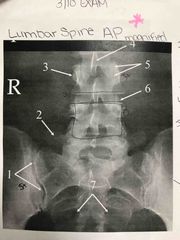
AP lumbar spine |
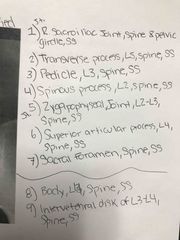
Back (Definition) |
|
|
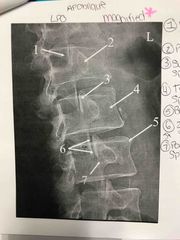
AP oblique -LPO |
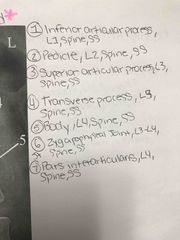
Back (Definition) |
|
|

AP oblique -LPO |
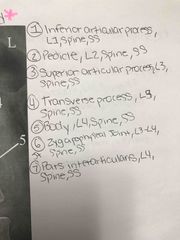
Back (Definition) |
|
|
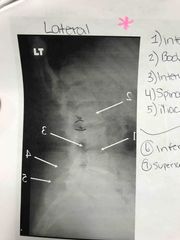
Lateral L-Spine |
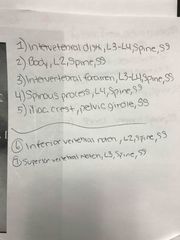
Back (Definition) |
|
|
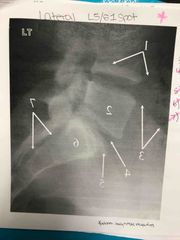
Lateral L5/S1 spot |
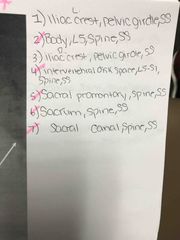
Back (Definition) |
|
|
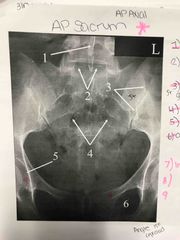
AP Axial sacrum |
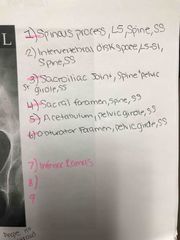
Back (Definition) |
|
|
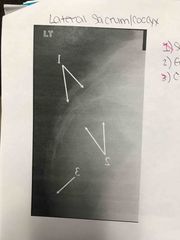
Lateral Sacrum/coccyx |
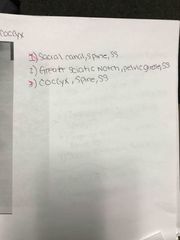
Back (Definition) |
|
|

Front (Term) |
Lateral aspect of lumbar vertebra p428 volume one |
|
|
|
Which vertebrae have demifacets both superiorly and inferiorly? |
T2-T8 |
|
|
|
The xiphoid process is in the same plane as which thoracic vertebra? |
T10 |
|
|
|
The stern all angle is in the same plane as which thoracic vertebra interspace? |
T4-T5 |
|
|
|
The stern all angle is in the same plane as which thoracic vertebra interspace? |
T4-T5 |
|
|
|
Name all thoracic vertebra which have WHOLE FACETS |
T1,T10,T11,T12 |
|
|
|
The stern all angle is in the same plane as which thoracic vertebra interspace? |
T4-T5 |
|
|
|
Name all thoracic vertebra which have WHOLE FACETS |
T1,T10,T11,T12 |
|
|
|
For Radiographic demonstration of the zygopophyseal joints of the thoracic region the patients body should be rotated ____ degrees from the anatomic position |
70-75 |
|
|
|
The stern all angle is in the same plane as which thoracic vertebra interspace? |
T4-T5 |
|
|
|
Name all thoracic vertebra which have WHOLE FACETS |
T1,T10,T11,T12 |
|
|
|
For Radiographic demonstration of the zygopophyseal joints of the thoracic region the patients body should be rotated ____ degrees from the anatomic position |
70-75 |
|
|
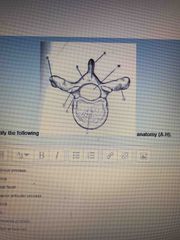
Front (Term) |

Back (Definition) |
|
|
|
The stern all angle is in the same plane as which thoracic vertebra interspace? |
T4-T5 |
|
|
|
Name all thoracic vertebra which have WHOLE FACETS |
T1,T10,T11,T12 |
|
|
|
For Radiographic demonstration of the zygopophyseal joints of the thoracic region the patients body should be rotated ____ degrees from the anatomic position |
70-75 |
|
|
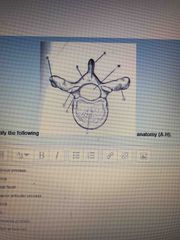
Front (Term) |

Back (Definition) |
|
|
|
The vertebral bodies of T10,T11, and T12 contain |
One whole facet |
|
|
|
Spondylolysis |
Breaking down of vertebrae |
|
|
|
Spondylolysis |
Breaking down of vertebrae |
|
|
|
Subluxation |
Incomplete or partial dislocation |
|
|
|
Spondylolysis |
Breaking down of vertebrae |
|
|
|
Subluxation |
Incomplete or partial dislocation |
|
|
|
Clay shovelers fracture |
Avulsion fracture of spinous process in lower cervical and upper thoracic region |
|
|
|
Spondylolysis |
Breaking down of vertebrae |
|
|
|
Subluxation |
Incomplete or partial dislocation |
|
|
|
Clay shovelers fracture |
Avulsion fracture of spinous process in lower cervical and upper thoracic region |
|
|
|
Ankylosing spondylitis |
RA involving SI joints and spine |
|
|
|
Spondylolysis |
Breaking down of vertebrae |
|
|
|
Subluxation |
Incomplete or partial dislocation |
|
|
|
Clay shovelers fracture |
Avulsion fracture of spinous process in lower cervical and upper thoracic region |
|
|
|
Ankylosing spondylitis |
RA involving SI joints and spine |
|
|
|
Spondylolisthesis |
Forward displacement of vertebrae over a lower vertebra |
|
|
|
Spondylolysis |
Breaking down of vertebrae |
|
|
|
Subluxation |
Incomplete or partial dislocation |
|
|
|
Clay shovelers fracture |
Avulsion fracture of spinous process in lower cervical and upper thoracic region |
|
|
|
Ankylosing spondylitis |
RA involving SI joints and spine |
|
|
|
Spondylolisthesis |
Forward displacement of vertebrae over a lower vertebra |
|
|
|
Hangman’s fracture |
Fracture of C2 due to hyper extension |
|
|
|
Spondylolysis |
Breaking down of vertebrae |
|
|
|
Subluxation |
Incomplete or partial dislocation |
|
|
|
Clay shovelers fracture |
Avulsion fracture of spinous process in lower cervical and upper thoracic region |
|
|
|
Ankylosing spondylitis |
RA involving SI joints and spine |
|
|
|
Spondylolisthesis |
Forward displacement of vertebrae over a lower vertebra |
|
|
|
Hangman’s fracture |
Fracture of C2 due to hyper extension |
|
|
|
Osteopetrosis |
Increased density of soft bone |
|
|
|
Spondylolysis |
Breaking down of vertebrae |
|
|
|
Subluxation |
Incomplete or partial dislocation |
|
|
|
Clay shovelers fracture |
Avulsion fracture of spinous process in lower cervical and upper thoracic region |
|
|
|
Ankylosing spondylitis |
RA involving SI joints and spine |
|
|
|
Spondylolisthesis |
Forward displacement of vertebrae over a lower vertebra |
|
|
|
Hangman’s fracture |
Fracture of C2 due to hyper extension |
|
|
|
Osteopetrosis |
Increased density of soft bone |
|
|
|
Pa gets disease |
Thick soft bone marked by bowing and fractures |
|
|
|
Jefferson fracture |
Comminuted fracture of ring of C1 |
|
|
|
Jefferson fracture |
Comminuted fracture of ring of C1 |
|
|
|
Kyphosis |
Abnormally increased posterior concavity of cervical and lumbar spine |
|
|
|
Jefferson fracture |
Comminuted fracture of ring of C1 |
|
|
|
Kyphosis |
Abnormally increased posterior concavity of cervical and lumbar spine |
|
|
|
Herniated nucleus pulposus |
Rupture or prolapse of nucleus pulposus into spinal canal |
|
|
|
Jefferson fracture |
Comminuted fracture of ring of C1 |
|
|
|
Kyphosis |
Abnormally increased posterior concavity of cervical and lumbar spine |
|
|
|
Herniated nucleus pulposus |
Rupture or prolapse of nucleus pulposus into spinal canal |
|
|
|
Lordosis |
Abnormally increased posterior convexity in thoracic curvature |
|
|
|
How should the patient be positioned to demonstrate the intervertebral foramina of the Tspine correctly? |
True lateral |
|
|
|
What 2 structures meet to form the Costotransverse Joint? |
Transverse process and the tubercle of the rib |
|
|

Front (Term) |
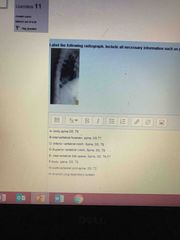
Back (Definition) |
|
|
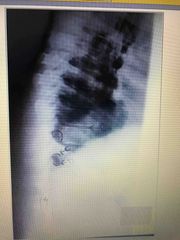
Front (Term) |

Back (Definition) |
|
|
|
Name the main parts of the sternum A) upper section _____ B) body ______ C) inferior aspect ____ |
Manubrium Gladiolus (middle portion) Xiphoid process T10 |
|
|
|
The zygopophyseal joints of the thoracic region angle |
Anteriorly 15-20 degrees |
|
|
|
The costovertebral joint is made up by the tubercle of the rib and the body of the transverse process |
FALSE |
|
|
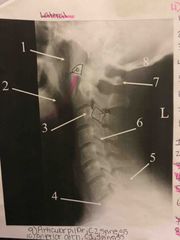
Lateral C-Spine |
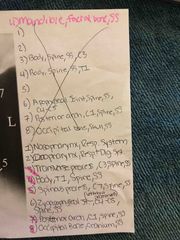
Back (Definition) |
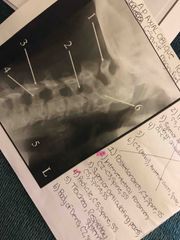
Also on test #2 & #4 |
|
|
C1 is also called |
Atlas |
|
|
|
C1 is a ring like structure but missing a ____ |
Vertebral body |
|
|
|
C1 has an |
-anterior arch -posterior arch -2 lateral masses -2 transverse processes |
|
|
|
Anterior and posterior arches form a ring which is divided into anterior and posterior portions by a ligament called ____ |
the Transverse Atlantal Ligament |
|
|
|
In C1 the anterior portion receives the ____ |
Dens(ODONTOID process/ C2) of the axis |
|
|
|
C2 is also called |
Axis |
|
|
|
C2 is received into the anterior portion of the atlantal ring to act as the pivot or body for the ___ |
Atlas C1 |
|
|
|
C7 is also called the |
Vertebra prominence which has a long SPINOUS PROCESS |
|
|
|
Typical Cervical vertebra C3-C6 |
TRANSVERSE PROCESSES are perforated by the transverse foramina for transmission of the vertebral artery and vein, and for the passage of the spinal nerves |
|
|
|
Typical cervical vertebrae All cervical vertebrae contain 3 foramina. List them. |
Right & Left Transverse foramina Vertebral foramen |
|
|
|
Typical cervical vertebrae All cervical vertebrae contain 3 foramina. List them. |
Right & Left Transverse foramina Vertebral foramen |
|
|
|
In typical vertebrae spinous processes are short and have double pointed tips called ___ |
BIFID |
|
|
|
Zygopophyseal joints of C2-C7 are clearly demonstrated in a ___ projection |
Lateral |
|
|
|
In typical cervical vertebrae the intervertebral foramina are directed _____ at a _____ angle from midsagittal plane and directed at a ____ angle to horizontal plane (inferior) |
ANTERIORLY , 45 degree 15 degree |
|
|
|
In typical cervical vertebrae to demonstrate the zygopophyseal joints of the C-spine a ___ projection is required. |
Lateral |
|
|
|
Atlanto-axial |
Atlas (C1)and axis (C2) -synovial, diarthrodial |
|
|
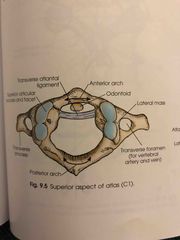
Front (Term) |
C-Spine superior aspect of atlas (C1) |
|
|
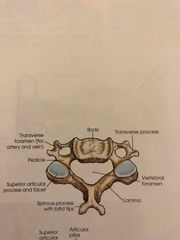
Front (Term) |
Superior aspect of typical cervical vertebra |
|
|
|
Rib viewed from posterior side Volume 1 pg 506 |

Back (Definition) |
|
|
|
The sternum is ____ in length |
6 inches |
|
|
|
The sternum is ____ in length |
6 inches |
|
|
|
The sternum has an easily palpable concavity termed the |
Jugular notch |
|
|
|
The sternum is ____ in length |
6 inches |
|
|
|
The sternum has an easily palpable concavity termed the |
Jugular notch |
|
|
|
Jugular notch is |
T2-T3 |
|
|
|
The sternum is ____ in length |
6 inches |
|
|
|
The sternum has an easily palpable concavity termed the |
Jugular notch |
|
|
|
Jugular notch is |
T2-T3 |
|
|
|
Sternal angle lies between |
T4-T5 interspace |
|
|
|
The Xiphoid process lies at |
T10 |
|
|
|
In ribs, the 1st-7th ribs attach |
Directly to the sternum |
|
|
|
Costal cartilages of the |
8th- 10th rubs attach to the COSTAL cartilages of the 7TH rib |
|
|
|
Ribs are situated in an oblique plane slanting anteriorly and inferiorly so their anterior ends _____ |
Lie 3 to 5 inches BELOW level of their vertebral ends |
|
|
|
Ribs are situated in an oblique plane slanting anteriorly and inferiorly so their anterior ends _____ |
Lie 3 to 5 inches BELOW level of their vertebral ends |
|
|
|
Ribs ____ are called false ribs because they DO NOT attach to the sternum |
8-12 |
|
|
|
Ribs are situated in an oblique plane slanting anteriorly and inferiorly so their anterior ends _____ |
Lie 3 to 5 inches BELOW level of their vertebral ends |
|
|
|
Ribs ____ are called false ribs because they DO NOT attach to the sternum |
8-12 |
|
|
|
The ___ & ____ ribs are called floating ribs because they attached ONLY to the vertebrae |
11th & 12th |
|
|
|
Ribs are situated in an oblique plane slanting anteriorly and inferiorly so their anterior ends _____ |
Lie 3 to 5 inches BELOW level of their vertebral ends |
|
|
|
Ribs ____ are called false ribs because they DO NOT attach to the sternum |
8-12 |
|
|
|
The ___ & ____ ribs are called floating ribs because they attached ONLY to the vertebrae |
11th & 12th |
|
|
|
Spaces between the ribs are referred to as the |
Intercostal spaces |
|
|
|
Located along the inferior and internal border of each rib is the ____ which contains costal arteries, veins & nerves |
Costal groove |
|
|
|
Located along the inferior and internal border of each rib is the ____ which contains costal arteries, veins & nerves |
Costal groove |
|
|
|
Costovertebral joint |
Head of a rib closely bound to the demifacets of 2 adjacent vertebral bodies |
|
|
|
Located along the inferior and internal border of each rib is the ____ which contains costal arteries, veins & nerves |
Costal groove |
|
|
|
Costovertebral joint |
Head of a rib closely bound to the demifacets of 2 adjacent vertebral bodies |
|
|
|
Costotransverse joint |
Tubercle of a rib articulates with anterior surface of the transverse process of lower vertebrae |
|
|
|
Located along the inferior and internal border of each rib is the ____ which contains costal arteries, veins & nerves |
Costal groove |
|
|
|
Costovertebral joint |
Head of a rib closely bound to the demifacets of 2 adjacent vertebral bodies |
|
|
|
Costotransverse joint |
Tubercle of a rib articulates with anterior surface of the transverse process of lower vertebrae |
|
|
|
Costochondral joint |
Ribs and costal cartilage |
|
|
|
Located along the inferior and internal border of each rib is the ____ which contains costal arteries, veins & nerves |
Costal groove |
|
|
|
Costovertebral joint |
Head of a rib closely bound to the demifacets of 2 adjacent vertebral bodies |
|
|
|
Costotransverse joint |
Tubercle of a rib articulates with anterior surface of the transverse process of lower vertebrae |
|
|
|
Costochondral joint |
Ribs and costal cartilage |
|
|
|
Position of diaphragm varies with body habitus. Higher level in _____ patient’s and at a lower level in ______ patients |
Hypersthenic ; asthenic |
|
|
|
Located along the inferior and internal border of each rib is the ____ which contains costal arteries, veins & nerves |
Costal groove |
|
|
|
Costovertebral joint |
Head of a rib closely bound to the demifacets of 2 adjacent vertebral bodies |
|
|
|
Costotransverse joint |
Tubercle of a rib articulates with anterior surface of the transverse process of lower vertebrae |
|
|
|
Costochondral joint |
Ribs and costal cartilage |
|
|
|
Position of diaphragm varies with body habitus. Higher level in _____ patient’s and at a lower level in ______ patients |
Hypersthenic ; asthenic |
|
|
|
The respiratory movement of the diaphragm averages about _____ between deep inspiration and expiration |
1 1/2 inches |
|
|
|
Located along the inferior and internal border of each rib is the ____ which contains costal arteries, veins & nerves |
Costal groove |
|
|
|
Costovertebral joint |
Head of a rib closely bound to the demifacets of 2 adjacent vertebral bodies |
|
|
|
Costotransverse joint |
Tubercle of a rib articulates with anterior surface of the transverse process of lower vertebrae |
|
|
|
Costochondral joint |
Ribs and costal cartilage |
|
|
|
Position of diaphragm varies with body habitus. Higher level in _____ patient’s and at a lower level in ______ patients |
Hypersthenic ; asthenic |
|
|
|
The respiratory movement of the diaphragm averages about _____ between deep inspiration and expiration |
1 1/2 inches |
|
|
|
The movement in the diaphragm is LESS in ___ patients and MORE in ____ |
Hypersthenic ; hyposthenic |
|

